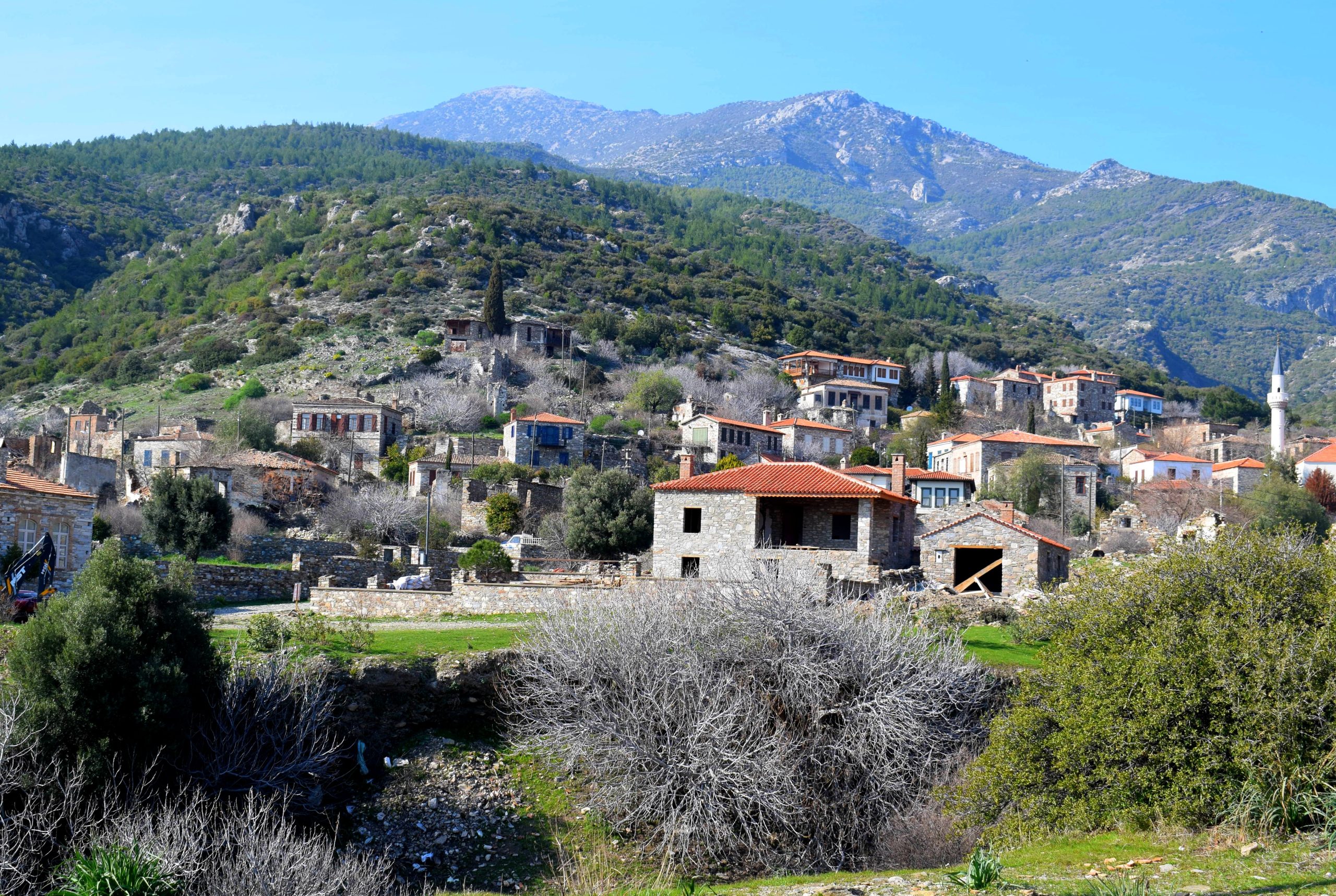If Kayakoy is the abandoned village that Fethiye never lost, then the Aegean tourist town of Didim has the ghostly, albeit largely forgotten offering of Eski Doğanbey.
Nestled silently, but imperiously in its own state of tumbledown elegance, the beautiful village of stone houses is tucked away on the southern hillsides of the Dilek Peninsula National Park.
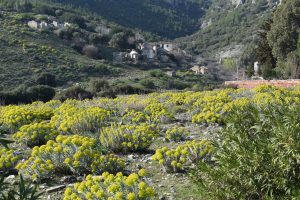
Yet as you contemplate the jaw-dropping views spreading out ahead to the horizon of the Büyük Menderes (Great Meander) river delta and into the Aegean from one of the windows of the local culture centre, it’s not hard to get lost in your own meanderings of the mind.
That is because the secrets of Eski Doğanbey are locked away forever in the dry stone walls, and beyond the high boundary walls of some of the refurbished homes that nudge you on almost imperceptibly, wanting to keep their own sad mysteries to themselves.
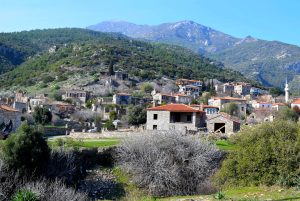
You see Eski Doğanbey, just as much as Kayakoy, has a deep, resounding sadness that silently echoes around the narrow, eerily, cobbled streets. Streets that are much a haunt for cats as it is for creeping flora that has slowly, silently regained the upper-hand in and around this startling gem.
Facing the village or outwards to the sea it makes you wonder what on earth happened here, why settle in the middle of nowhere, and then to abandon it so wilfully. The village slumbers on, never giving, never telling.

Mysteries of time
Eski Doganbey was a thriving Greek settlement in the late 19th century. The village, originally known as Domatia (meaning rooms in Greek), stands at the foot of the Samsun mountain.
Legend has it that there has been a settlement here since the 7th century. In the late 19th century, Sultan II, Abdülhamit Han, established himself and created a commercial centre for the needs of the Aegean islands. Greek, Cypriot, Crete, Kula and other places of commerce, arts and craftsmen lived and traded through Samos (Sisam).
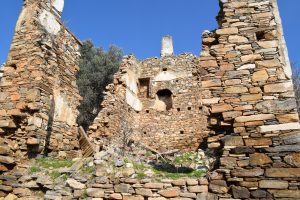
Domatia, now with a population of 300 people, thrived as a point for Greek Cypriots. One website suggests that during and after World War I (1914-18), these villagers cooperated with the English and the Greeks and hid Greek-Cypriot gangs in Domatia who thwarted pre-Turkish villages on the plains from Samos.
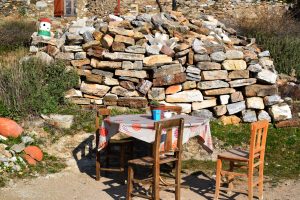
The continuing skirmishes between Domatia and the Turkish militia have resulted in empty shell casings being found on the streets of the old village today. However, when the Turkish army entered Izmir in 1922, the Greek Cypriots abandoned their positions and fled.
1924 – a turning point
In 1924, at the point of the population exchange between Greece and Turkey following the Turkish War of Independence under Ataturk, the Greeks moved out of Domatia and were resettled in Thessaloniki.
It is said the beautiful homes were destroyed by the leaving Greeks in 1924 out of emotional despair at having to be relocated away from what they called home. Leaving the buildings in disrepair and ruin, left the newly re-homed ‘Turks’ with an uphill struggle to survive.

The new arrivals were either claimed to be Albanians from Bosnia and Thessaloniki; Kurds in the wake of the failed Sheikh Sait rebellion in 1925, or Turks from Selanik in Greece as a result of the population exchange.
Whatever happened during those fateful 12 months, Domatia was renamed Doganbey.
However, the fate of the village appeared to be sealed with many of the new villagers facing the barren and windy conditions, and the mountainous, rugged and unforgiving nature for agricultural concerns.

As mechanized farming came into being, the farmers looked for flatter land nearby. While the village remained operational, time was finally called in 1985 due to the infrastructure, such as the narrow cobbled streets, and the limited potential to expand facilities.
A new settlement was located less than a kilometre just below the village and named Yeni Doğanbey (Yeni meaning new, while eski means old in Turkish).
Eski to Yeni and back
The homes of the old village were largely abandoned to their fate. In 1996, a large fire burnt down trees on the hillsides and contributed to a lack of flow of water down into the village, which is divided in two by a small creek.

As ruins, the stone houses were still exceptionally beautiful and it was during the late 90s that they were re-discovered and attempts were put in motion to get the buildings back up to their former glories.

It is with that effort, energy, commitment and patience, the village of 2017 is a mix of beauty and sadness. Today’s new ‘inhabitants’ range from German dignitaries, public school officials, writers and artists who have a romantic view of the need to retain the Greek and Turkish architecture.

The ruined structures are slowly being restored at a slow pace, but that probably offers a greater romantic drive of a village that has until recently no bakers, no greengrocers, bar or tacky souvenir shops.

From inquiries we made, the restorations projects have to conform to the Turkish protectionist laws and all the Greek houses are under the protection of the SIT. They can only be restored by being strictly faithful to the originals.
As much as the residents of these homes would rather live their lives in peace and relative tranquillity, they have become battle-hardened to the tourists that venture into these environs with cameras and off-the-beaten track to capture what is evolving today,
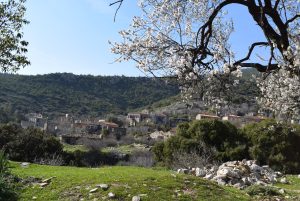
Culture centre
Much of the tourist focus lies in the hands – of the building – of the former hospital, former school, and now culture centre that stands at the lower end of the village.
When you approach on the road to the village, you have a choice in which there is a left turn: this is to the culture centre. Going straight on means chancing your luck at an unofficial car park off to the left.

The centre – the National Dilek Natural Park Museum – is under the leadership of Nevzat, an enthusiastic forest engineer. The building was restored with the help of M. Fikri Aktan.
It now acts as a focal point for tourists to discover the wide range and bewildering array of animals and species in the surrounding hills and across the Meanderos delta.
Flora and fauna
The national park belongs to 95 families. There are 804 plant species, subspecies and varieties. Six of these are the only species seen here in the world. You can also find 31 plant species endemic to Turkey in this region. The National Park was declared a “Flora Bio Genetic Reserve Area” by the Council of Europe because of its unique plant diversity.

The culture centre also has a room set aside for bird and animal species which exist in these parts.
New Ottoman museum
A new museum, if you can find it, was opened in 2015, within one of the restored buildings, housing Ottoman costumes and their products, rumoured to be the second largest in Turkey.
The museum, prepared by Emel Aksoy, is one of the most important ethnographic collections of the country.

 Artist Oylum Öktem İşözen, one of the residents of old Doğanbey Village, who made a speech at the opening ceremony, said they had been excitedly waiting for the opening of the museum for 2-3 years.
Artist Oylum Öktem İşözen, one of the residents of old Doğanbey Village, who made a speech at the opening ceremony, said they had been excitedly waiting for the opening of the museum for 2-3 years.
Şakir Pasha, one of the two Grand Viziers of the Ottoman Sultan Abdulhamit II, and Emel Aksoy, the granddaughter of Shakir Pasha, the Governor of Adana during the reign of Abdulhamit II, expressed happiness that the museum had been realized.
The museum exhibits clothes, goods, needle-holders, headwear and period pieces of clothing collected from different parts of the country of the 19th and 20th centuries
Cafes and hotels
There is Mola Café run by Demir and his family, while there is also a pension (Mola Pension) and two boutique hotels (Domaça House and Casa Luna) as well as a charming lodge (Eski Doganbey House). Looking on airbnb.com, there is also White Mansion which is said to be in the heart of the village, with renting per night at 392TL.
Lasting impressions:
The village is an open-air museum to Greek and Turkish architecture. Dedicating at least a relaxing to three hours hunting round the narrow streets, abandoned builds and trying to look over the high walls of those properties that have been refurbished is all part of the fun and the mystery of who lived there and who now lives here.

Equally, taking in the silence of the place as nature abounds in spring (March, April, May) and autumn (September, October, November) really enhances the feeling that someone has found their Utopia.
The culture centre is worth a good half-an-hour to wander through and take in the views, while the Mola Cafe is just as accommodating.
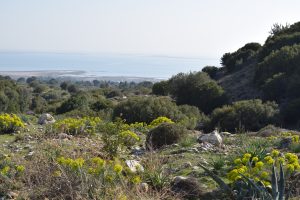
However, it is the opportunity to get away from the hustle and bustle, recharge those batteries and simply become immersed in your own thoughts that really makes Eski Doğanbey a mystery.
A mystery that lingers as much as the ghostly memories of times gone by.
How to get there
By car:
Eski Doganbey lies about one hour’s driving from Didim, through Akkoy, turn left for the signs for Miletus and Priene, and continue down that road, past the Miletus ruins and on until you come to a sign for Doganbey. If you look at the mountain ahead, you will need to go off to the left. Follow this road all the way and Eski Doganbey is signposted off to the right. If you carry on and hit the village of Karina you have gone too far.

From Kusadasi and Izmir. Zero in on getting to Soke and on the Soke-Bodrum road at the outskirts of Soke you’ll find an island and a sign for Güllübahçe and Priene. Head down this road and you’ll eventually carry straight on and see signs for Doğanbey. The distance from Soke and Eski Doğanbey is 35 minutes (30km).
